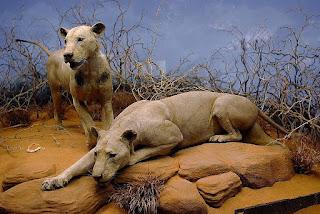I don't really think that I need to describe the lion to you, but I'll try for some more obscure facts about physical characteristics. Coloration in lions varies from buff to yellowish, reddish, or dark brown, with lighter underparts and a black tail tuft. Cubs are born with rosettes on their body that fade as they reach adulthood, although lionesses have been known to retain faint spots on their legs and underparts. The lion is tallest of all kitties, measuring up to 3.9 feet at the shoulders. Head and body length in males ranges from 5'7" - 8'2" and in females from 4'7" - 5'9". The longest lion on record was a 12 foot lion with a black mane shot near Mucsso in southern Angola, while the heaviest lion on record weighed a whopping 690 pounds. On a side note, this heaviest lion was a man-eater, so he probably packed on a few pounds from that little habit...Another distinct lion characteristic is sexual dimorphism, meaning that female and male animals look different. In fact, lions are the only members of the cat family to display such obvious dimorphism. The most obvious trait differing the males from the females is the male's mane. The presence or absence, color, and size of the mane provides hints about genetic precondition, sexual maturity, climate, and testosterone. In general, the darker and fuller the mane, the healthier the lion. For this reason, females tend to favor males with the densest, darkest mane. So in the Lion King, Mufasa and Scar are tied - Scar has the darkest mane, but Mufasa's is definitely the fullest...
There are unusual lions out there, and lion hybrids as well. The white lion is a special morph with a genetic condition call leucism that causes paler coloration. They are not albinos, however, because they have normal pigmentation in the eyes and skin. White Transvaal Lions are different than a simple white lion, apparently. The white Transvaal Lions have cream coats due to a recessive gene. Lion have also been known to breed with other members of the cat family, producing unusual hybrids. The most well-known of these hybrids is the liger (male lion x female tigress) and the tiglon (female lion x male tiger), which results from a lion breeding with a tiger. The liger inherits a growth-promoting gene passed on from male lion, but the growth-inhibiting gene from the female tiger is absent, causing ligers to grow larger than either parent. Ligers are typically between 10 and 12 feet and can weigh up to 1,000 pounds. Lions have also bred with leopards to produce leopons, and jaguars to produce jaglion. The marozi is a naturally occurring leopon.
 |
| White Transvaal Lion |
 |
| Tiglon |
 |
| Jaglion |
 |
| Leopon |
 |
| Liger |
 |
| White Lion |
In a pride, lionesses do most of the hunting for the pride, since they are smaller, swifter, and more agile than the males who have cumbersome manes slowing them down. Also, the lioness is more aggressive by nature than the male, who usually stays and watches his young while waiting for the lionesses to return with dinner. The lionesses act as a co-ordinated group to bring down prey successfully. Males tend to dominate the kill once the lionesses have succeeded (typical male behavior). Lions do not have a great amount of stamina, and can only run in short bursts. Prey consists mainly of large mammals, including wildebeest, impalas, zebras, buffalo, and warthogs. If pressed, lionesses can even take down giraffes, buffalo, hippopotamus and elephants. A lion can eat up to 66 pounds in one sitting. WARNING: The video below ends with a successful elephant kill...don't watch if you don't want to see it...
While lions do not usually hunt people, some (usually male) do end up seeking human prey. The most famous of the man-eaters are the Tsavo maneaters, who took 28 railway workers building the Kenya-Uganda Railway in 1898. Man-eating lions have several characteristics in common: they have all been larger than normal, lacked manes, and seemed to be suffering from tooth decay.
 |
| Tsavo Man-eaters |
As for cubs, if a new male ousts the previous males associated with the pride, the conqueror often will kill any existing young cubs. This seems to be a method to get the females fertile again, since they do not become receptive towards males until their cubs mature or die. As many as 80% of lion cubs die before 2 years of age due to starvation, male lions, and predation dangers. This is not good news for lions, because their numbers are decreasing rapidly. Disease, human interference, and habitat loss seem to be the most significant threats.
CHEETAH TIME!!!
The cheetah has a 50% chance of losing its kill to lions or other predators. Lions are the major killers of cheetah cubs, up to 90% of which are lost in their first weeks of life due to attacks by lions or other predators. This movie isn't sad, though, I promise!




No comments:
Post a Comment